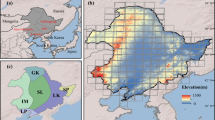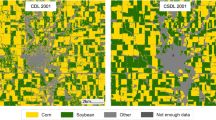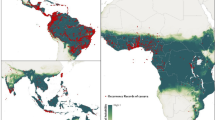Abstract
The rapid expansion of soybean-growing areas across Europe raises questions about the suitability of agroclimatic conditions for soybean production. Here, using data-driven relationships between climate and soybean yield derived from machine-learning, we made yield projections under current and future climate with moderate (Representative Concentration Pathway (RCP) 4.5) to intense (RCP 8.5) warming, up to the 2050s and 2090s time horizons. The selected model showed high R2 (>0.9) and low root-mean-squared error (0.35 t ha−1) between observed and predicted yields based on cross-validation. Our results suggest that a self-sufficiency level of 50% (100%) would be achievable in Europe under historical and future climate if 4–5% (9–11%) of the current European cropland were dedicated to soybean production. The findings could help farmers, extension services, policymakers and agribusiness to reorganize the production area distribution. The environmental benefits and side effects, and the impacts of soybean expansion on land-use change, would need further research.
This is a preview of subscription content, access via your institution
Access options
Access Nature and 54 other Nature Portfolio journals
Get Nature+, our best-value online-access subscription
$29.99 / 30 days
cancel any time
Subscribe to this journal
Receive 12 digital issues and online access to articles
$119.00 per year
only $9.92 per issue
Buy this article
- Purchase on Springer Link
- Instant access to full article PDF
Prices may be subject to local taxes which are calculated during checkout





Similar content being viewed by others
Data availability
The soybean yield projections generated during this study have been deposited in the Zenodo repository (https://doi.org/10.5281/zenodo.6136215) (ref. 81)
Code availability
The R code to reproduce key results of this paper is available at: https://github.com/nguilpart/soybean_yield_projections_europe
References
FAOSTAT Statistics Database (Food and Agriculture Organization of the United Nations, 2019); http://www.fao.org/faostat/en/#data
Magrini, M. B. et al. Why are grain-legumes rarely present in cropping systems despite their environmental and nutritional benefits? Analyzing lock-in in the French agrifood system. Ecol. Econ. 126, 152–162 (2016).
Zander, P. et al. Grain legume decline and potential recovery in European agriculture: a review. Agron. Sustain. Dev. 36, 26 (2016).
Cernay, C., Makowski, D. & Pelzer, E. Preceding cultivation of grain legumes increases cereal yields under low nitrogen input conditions. Environ. Chem. Lett. 16, 631–636 (2018).
Nemecek, T. et al. Environmental impacts of introducing grain legumes into European crop rotations. Eur. J. Agron. 28, 380–393 (2008).
Gaba, S. et al. Multiple cropping systems as drivers for providing multiple ecosystem services: from concepts to design. Agron. Sustain. Dev. 35, 607–623 (2014).
Jensen, E. S. et al. Legumes for mitigation of climate change and the provision of feedstock for biofuels and biorefineries. A review. Agron. Sustain. Dev. 32, 329–364 (2012).
Foyer, C. H. et al. Neglecting legumes has compromised human health and sustainable food production. Nat. Plants 2, 16112 (2016).
Messina, M., Rogero, M. M., Fisberg, M. & Waitzberg, D. Health impact of childhood and adolescent soy consumption. Nutr. Rev. 75, 500–515 (2017).
Jayachandran, M. & Xu, B. An insight into the health benefits of fermented soy products. Food Chem. 271, 362–371 (2019).
Dold, C. et al. Long-term carbon uptake of agro-ecosystems in the Midwest. Agric. For. Meteorol. 232, 128–140 (2017).
Gilmanov, T. G. et al. Productivity and carbon dioxide exchange of leguminous crops: estimates from flux tower measurements. Agron. Journa 106, 545–559 (2014).
Urruty, N., Deveaud, T., Guyomard, H. & Boiffin, J. Impacts of agricultural land use changes on pesticide use in French agriculture. Eur. J. Agron. 80, 113–123 (2016).
Rüdelsheim, P. L. J. & Smets, G. Baseline information on agricultural practices in the EU soybean (Glycine max (L.) Merr.). Perseus BVBA (2012).
Martin, N. Domestic soybean to compensate the European protein deficit: illusion or real market opportunity? Oilseeds Fats Crops Lipids 22, D502 (2015).
Krön, M. & Bittner, U. Danube soya—Improving European GM-free soya supply for food and feed. Oilseeds Fats Crops Lipids 22, D509 (2015).
OECD‑FAO Agricultural Outlook 2019–2028 (OECD/FAO, 2019).
Iizumi, T. et al. Historical changes in global yields: major cereal and legume crops from 1982 to 2006. Glob. Ecol. Biogeogr. 23, 346–357 (2014).
Iizumi, T. et al. Uncertainties of potentials and recent changes in global yields of major crops resulting from census- and satellite-based yield datasets at multiple resolutions. PLoS ONE 13, e0203809 (2018).
Iizumi, T., Okada, M. & Yokozawza, M. A meteorological forcing data set for global crop modeling: development, evaluation, and intercomparison. J. Geophys. Res. Atmos. Res. 119, 363–384 (2014).
Roberts, D. R. et al. Cross-validation strategies for data with temporal, spatial, hierarchical, or phylogenetic structure. Ecography 40, 913–929 (2017).
Taylor, K. E., Stouffer, R. J. & Meehl, G. A. An overview of CMIP5 and experiment design. Am. Meteorol. Soc. 93, 485–498 (2012).
Van Vuuren, D. P. et al. The representative concentration pathways: an overview. Clim. Change 109, 5–31 (2011).
Koutroulis, A. G. et al. Freshwater vulnerability under high end climate change. A pan-European assessment. Sci. Total Environ. 614, 271–286 (2018).
Rosenzweig, C. et al. Assessing agricultural risks of climate change in the 21st century in a global gridded crop model intercomparison. Proc. Natl Acad. Sci. USA 111, 3268–3273 (2014).
Müller, C. et al. The Global Gridded Crop Model Intercomparison phase 1 simulation dataset. Sci. Data 6, 1–22 (2019).
Schlenker, W. & Roberts, M. J. Nonlinear temperature effects indicate severe damages to US crop yields under climate change. Proc. Natl Acad. Sci. 106, 15594–15598 (2009).
Mourtzinis, S. et al. Climate-induced reduction in US-wide soybean yields underpinned by region- and in-season specific responses. Nat. Plants 1, 14026 (2015).
Ramankutty, N., Evan, A. T., Monfreda, C. & Foley, J. A. Farming the planet: 1. Geographic distribution of global agricultural lands in the year 2000. Global Biogeochem. Cycles 22, 1–19 (2008).
Sustainable Land Use (Greening) (European Commission, accessed March 2022); https://ec.europa.eu/info/food-farming-fisheries/key-policies/common-agricultural-policy/income-support/greening_en
Đorđević, V., Malidža, G., Vidić, M., Milovac, Ž. & Šeremešić, S. Best Practice Manual for Soya Bean Cultivation in the Danube Region (Danube Soya, 2016).
Hartman, G. L., West, E. D. & Herman, T. K. Crops that feed the world 2. Soybean-worldwide production, use, and constraints caused by pathogens and pests. Food Secur. 3, 5–17 (2011).
Pannecoucque, J. et al. Screening for soybean varieties suited to Belgian growing conditions based on maturity, yield components and resistance to Sclerotinia sclerotiorum and Rhizoctonia solani anastomosis group 2-2IIIB. J. Agric. Sci. https://doi.org/10.1017/S0021859618000333 (2018).
Grandes cultures biologiques—Les clés de la réussite (Chambres d’agriculture de France, 2017).
Grassini, P., Specht, J. E., Tollenaar, M., Ciampitti, I. & Cassman, K. G. High-yield maize–soybean cropping systems in the US Corn Belt, in Crop Physiology: Applications for Genetic Improvement and Agronomy, (eds Sadras, V. O. & Calderini, D. F.) 17-41 (Academic Press, 2015).
Salembier, C., Elverdin, J. H. & Meynard, J. Tracking on-farm innovations to unearth alternatives to the dominant soybean-based system in the Argentinean pampa. Agron. Sustain. Dev. https://doi.org/10.1007/s13593-015-0343-9 (2016).
Mueller, N. D. et al. Closing yield gaps through nutrient and water management. Nature 490, 254–257 (2012).
Monfreda, C., Ramankutty, N. & Foley, J. A. Farming the planet: 2. Geographic distribution of crop areas, yields, physiological types, and net primary production in the year 2000. Global Biogeochem. Cycles 22, 1–19 (2008).
Kurasch, A. K. et al. Identification of mega-environments in Europe and effect of allelic variation at maturity E loci on adaptation of European soybean. Plant, Cell Environ. 40, 765–778 (2017).
Houlton, B. Z. et al. A world of cobenefits: solving the global nitrogen challenge. Earths Future 7, 865–872 (2019).
Weisberger, D., Nichols, V. & Liebman, M. Does diversifying crop rotations suppress weeds? A meta-analysis. PLoS ONE 14, 1–12 (2019).
Gibson, K. E. B., Gibson, J. P. & Grassini, P. Benchmarking irrigation water use in producer fields in the US central great plains. Environ. Res. Lett. 14, 054009 (2019).
Nori, J. et al. Protected areas and spatial conservation priorities for endemic vertebrates of the Gran Chaco, one of the most threatened ecoregions of the world. Divers. Distrib. 22, 1212–1219 (2016).
Fehlenberg, V. et al. The role of soybean production as an underlying driver of deforestation in. Glob. Environ. Chang. 45, 24–34 (2017).
Meyfroidt, P. et al. Middle-range theories of land system change. Glob. Environ. Chang. 53, 52–67 (2018).
Delerce, S. et al. Assessing weather-yield relationships in rice at local scale using data mining approaches. PLoS ONE 11, e0161620 (2016).
Everingham, Y., Sexton, J., Skocaj, D. & Inman-Bamber, G. Accurate prediction of sugarcane yield using a random forest algorithm. Agron. Sustain. Dev. 36, 27 (2016).
Jeong, J. H. et al. Random forests for global and regional crop yield predictions. PLoS ONE 11, e0156571 (2016).
Partridge, T. F. et al. Mid-20th century warming hole boosts US maize yields. Environ. Res. Lett. 14, 114008 (2019).
Cernay, C., Pelzer, E. & Makowski, D. A global experimental dataset for assessing grain legume production. Sci. Data 3, 160084 (2016).
Setiyono, T. D. et al. Understanding and modeling the effect of temperature and daylength on soybean phenology under high-yield conditions. Field Crop. Res. 100, 257–271 (2007).
Hafner, S. Trends in maize, rice, and wheat yields for 188 nations over the past 40 years: a prevalence of linear growth. Agric. Ecosyst. Environ. 97, 275–283 (2003).
Schoving, C. et al. Combining simple phenotyping and photothermal algorithm for the prediction of soybean phenology: application to a range of common cultivars grown in Europe. Front. Plant Sci. 10, 1–14 (2020).
Folberth, C. et al. Uncertainty in soil data can outweigh climate impact signals in global crop yield simulations. Nat. Commun. 7, 1–13 (2016).
Guilpart, N. et al. Rooting for food security in sub-Saharan Africa. Environ. Res. Lett. 12, 114036 (2017).
Shangguan, W., Hengl, T., Mendes de Jesus, J., Yuan, H. & Da, Y. Mapping the global depth to bedrock for land surface modeling. J. Adv. Model. Earth Syst. 9, 65–88 (2017).
Jones, A., Montanarella, L. & Jones, R. Soil Atlas of Europe (European Commission, 2005).
Cober, E. R. & Morrison, M. J. Soybean yield and seed composition changes in response to increasing atmospheric CO2 concentration in short-season Canada. Plants 8, 250 (2019).
Thomey, M. L., Slattery, R. A., Bernacchi, C. J., Köhler, I. H. & Ort, D. R. Yield response of field‐grown soybean exposed to heat waves under current and elevated [CO2]. Glob. Chang. Biol. 25, 4352–4368 (2019).
Vera, U. M. R., Bernacchi, C. J., Siebers, M. H. & Ort, D. R. Canopy warming accelerates development in soybean and maize, offsetting the delay in soybean reproductive development by elevated CO2 concentrations. Plant Cell Environ. 41, 2806–2820 (2018).
Li, Y. et al. Elevated CO2 increases nitrogen fixation at the reproductive phase contributing to various yield responses of soybean cultivars. Front. Plant Sci. 8, 1546 (2017).
Gray, S. B. et al. Intensifying drought eliminates the expected benefits of elevated carbon dioxide for soybean. Nat. Plants 2, 16132 (2016).
Xu, G. et al. Soybean grown under elevated CO2 benefits more under low temperature than high temperature stress: varying response of photosynthetic limitations, leaf metabolites, growth, and seed yield. J. Plant Physiol. 205, 20–32 (2016).
Makowski, D., Marajo-Petitzon, E., Durand, J. L. & Ben-Ari, T. Quantitative synthesis of temperature, CO2, rainfall, and adaptation effects on global crop yields. Eur. J. Agron. 115, 126041 (2020).
Sacks, W. J., Deryng, D., Foley, J. A. & Ramankutty, N. Crop planting dates: an analysis of global patterns. Glob. Ecol. Biogeogr. 19, 607–620 (2010).
Ruane, A. C., Goldberg, R. & Chryssanthacopoulos, J. Climate forcing datasets for agricultural modeling: merged products for gap-filling and historical climate series estimation. Agric. For. Meteorol. 200, 233–248 (2015).
You, L., Wood, S., Wood-Sichra, U. & Wu, W. Generating global crop distribution maps: from census to grid. Agric. Syst. 127, 53–60 (2014).
Grassini, P. et al. Soybean yield gaps and water productivity in the western US Corn Belt. Field Crops Res. 179, 150–163 (2015).
Merlos, F. A. et al. Potential for crop production increase in Argentina through closure of existing yield gaps. Field Crops Res. 184, 145–154 (2015).
Sentelhas, P. C. et al. The soybean yield gap in Brazil—magnitude, causes and possible solutions for sustainable production. J. Agric. Sci. 153, 1394–1411 (2015).
Grassini, P., Eskridge, K. M. & Cassman, K. G. Distinguishing between yield advances and yield plateaus in historical crop production trends. Nat. Commun. 4, 2918 (2013).
Rubel, F., Brugger, K., Haslinger, K. & Auer, I. The climate of the European Alps: shift of very high resolution Köppen–Geiger climate zones 1800-2100. Meteorol. Zeitschrift 26, 115–125 (2017).
Dupin, M. et al. Effects of the training dataset characteristics on the performance of nine species distribution models: application to Diabrotica virgifera virgifera. PLoS ONE 6, e20957 (2011).
Günther, F. & Fritsch, S. neuralnet: training of neural networks. R J 2, 30–38 (2010).
Wright, M. N. & Ziegler, A. ranger: a fast implementation of random forests for high dimensional data in C++ and R. J. Stat. Softw. 77, 1–17 (2017).
Hastie, T. gam: Generalized Additive Models, R package, version 0.98 (R Foundation for Statistical Computing, 2013).
Minamikawa, K., Fumoto, T., Iizumi, T., Cha-un, N. & Pimple, U. Prediction of future methane emission from irrigated rice paddies in central Thailand under different water management practices. Sci. Total Environ. 566–567, 641–651 (2016).
Rosenzweig, C. et al. The Agricultural Model Intercomparison and Improvement Project (AgMIP): protocols and pilot studies. Agric. For. Meteorol. 170, 166–182 (2013).
Rosenzweig, C. et al. Assessing agricultural risks of climate change in the 21st century in a global gridded crop model intercomparison. Proc. Natl Acad. Sci. USA 111, 3268–3273 (2014).
Villoria, N. B. et al. Rapid aggregation of global gridded crop model outputs to facilitate cross-disciplinary analysis of climate change impacts in agriculture. Environ. Model. Softw. 75, 193–201 (2016).
Guilpart, N., Iizumi, T. & Makowski, D. Soybean yield projections in Europe under historical (1981–2010) and future climate (2050–2059 and 2090–2099 for RCP4.5 and RCP8.5) [Dataset] (Zenodo, 2022); https://doi.org/10.5281/zenodo.6136216
Acknowledgements
This work was supported by the CLAND convergence institute (16-CONV-0003) funded by the French National Research Agency (ANR), by the ACCAF INRA meta-programme (COMPROMISE project, COMPROMISE_MP-P10177) and by the LegValue project funded by the European Union’s Horizon 2020 research and innovation programme under grant agreement number 727672. T.I. was partly supported by the Environment Research and Technology Development Fund (S-14) of the Environmental Restoration and Conservation Agency of Japan and Grant-in-Aid for Scientific Research (16KT0036, 17K07984 and 18H02317) of JSPS.
Author information
Authors and Affiliations
Contributions
N.G and D.M. designed research and performed the analysis. T.I. supplied yield and cliamte data. N.G. wrote the manuscript, with substantial contributions from all co-authors. D.M. initiated research.
Corresponding author
Ethics declarations
Competing interests
The authors declare no competing interests.
Peer review
Peer review information
Nature Food thanks Zvi Hochman and the other, anonymous, reviewer(s) for their contribution to the peer review of this work.
Additional information
Publisher’s note Springer Nature remains neutral with regard to jurisdictional claims in published maps and institutional affiliations.
Supplementary information
Supplementary Information
Supplementary Figs. 1–28, Tables 1–11, discussion and references.
Rights and permissions
About this article
Cite this article
Guilpart, N., Iizumi, T. & Makowski, D. Data-driven projections suggest large opportunities to improve Europe’s soybean self-sufficiency under climate change. Nat Food 3, 255–265 (2022). https://doi.org/10.1038/s43016-022-00481-3
Received:
Accepted:
Published:
Issue Date:
DOI: https://doi.org/10.1038/s43016-022-00481-3
This article is cited by
-
Swiss agriculture can become more sustainable and self-sufficient by shifting from forage to grain legume production
Communications Earth & Environment (2024)
-
European soybean to benefit people and the environment
Scientific Reports (2024)
-
China can be self-sufficient in maize production by 2030 with optimal crop management
Nature Communications (2023)
-
Key role of planted and harvested area fluctuations in US crop production shocks
Nature Sustainability (2023)
-
An experimental dataset on yields of pulses across Europe
Scientific Data (2023)



